About Mysore
Mysore or Mysuru, is the third largest city in Karnataka. The city was ruled by the Wodeyar dynasty and it is well known for the rich architectural history, palaces, and beautiful gardens. It is located at the bottom of the Chamundi Hills and is about 150 kms from Bangalore.The city has a large tourism industry, which attracts tourists from all across the World. The city is famous for the palaces, the delicious Pak and the Dashara celebration in the city. It is one of the most visited destinations in Karnataka.
DAY 1 PICKUP FROM MYSORE: Hotel /Airport / Railway Station / Bus Station and proceed to Mysore Local Sightseeing places including:
CHAMUNDI HILL TEMPLE
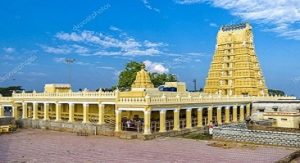 Chamundi Hill is very famous for Chamundeswari temple dedicated to Goddess Chamundeswari, an incarnation of Goddess Parvathi who took this form to destroy Mahishasura. Also known as Krouncha Pitham, Chamundi Temple is one among the 18 Maha Shakti Peethas representing the hair of Sati Devi and among the prime place to visit on a Mysore trip. This is one of the major pilgrimage sites in Karnataka and one of the top places to visit in Mysore.At an altitude of 1065 meters, the temple on Chamundi Hill was built in 11th century. For centuries, the Wodeyars of Mysore revered the deity and made extensive contributions to this shrine. The idol of goddess Chamundi inside the central sanctum was made with pure gold. The temple is a fine example of Dravidian temple architecture. The temple possesses lots of images of Nandi. The most famous is the 15 feet high and 24 feet long Nandi on the 800th step on the hill.
Chamundi Hill is very famous for Chamundeswari temple dedicated to Goddess Chamundeswari, an incarnation of Goddess Parvathi who took this form to destroy Mahishasura. Also known as Krouncha Pitham, Chamundi Temple is one among the 18 Maha Shakti Peethas representing the hair of Sati Devi and among the prime place to visit on a Mysore trip. This is one of the major pilgrimage sites in Karnataka and one of the top places to visit in Mysore.At an altitude of 1065 meters, the temple on Chamundi Hill was built in 11th century. For centuries, the Wodeyars of Mysore revered the deity and made extensive contributions to this shrine. The idol of goddess Chamundi inside the central sanctum was made with pure gold. The temple is a fine example of Dravidian temple architecture. The temple possesses lots of images of Nandi. The most famous is the 15 feet high and 24 feet long Nandi on the 800th step on the hill.
SAND MUSEUM
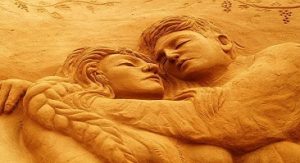 Sand sculpture Museum displays around 150 sculptures of sand in 16 different themes, which have been placed over an area of 13500 sq. feet. These sand sculptures have been created using more than 115 truckloads of sand. Various interesting themes have been used at the museum ranging from mysore heritage, wildlife, culture, instances from different religious epics and fairy tales and stories.At the entrance of the museum, tourists will see a statue of Lord Ganesha, which has a height of 15 feet. Other sand sculptures at the museum are of Goddess Chamundeshwari, erstwhile Mysore King Srikanta Datta Narasimharaja Wadiyar who is shown seated on his throne during a Dasara festival, Lord Krishna and Arjuna on a horse-drawn chariot, Laughing Buddha, Christmas tree and Santa Claus, Disneyland, ancient Egypt, zodiac wheel, instances from Arabian nights, Tom & Jerry cartoon, etc.
Sand sculpture Museum displays around 150 sculptures of sand in 16 different themes, which have been placed over an area of 13500 sq. feet. These sand sculptures have been created using more than 115 truckloads of sand. Various interesting themes have been used at the museum ranging from mysore heritage, wildlife, culture, instances from different religious epics and fairy tales and stories.At the entrance of the museum, tourists will see a statue of Lord Ganesha, which has a height of 15 feet. Other sand sculptures at the museum are of Goddess Chamundeshwari, erstwhile Mysore King Srikanta Datta Narasimharaja Wadiyar who is shown seated on his throne during a Dasara festival, Lord Krishna and Arjuna on a horse-drawn chariot, Laughing Buddha, Christmas tree and Santa Claus, Disneyland, ancient Egypt, zodiac wheel, instances from Arabian nights, Tom & Jerry cartoon, etc.
WAX MUSEUM
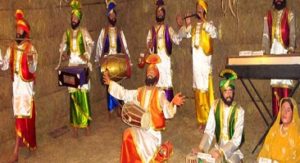 The Wax Museum, also popular as Melody Wax Museum, boasts of 19 galleries and more than 300 musical instruments, showcased in various bands including Indian classical, Hip Hop, Jazz, Punjabi Bhangra and Rock. Created by an IT professional, Shreeji Bhaskaran in 2010 and set up in a 90 year old building, the museum is worth a visit.Conceptualized and developed by the collective efforts of both Shreeji Bhaskaran and his wife Reena, the museum is a tribute to all the honoured musicians across the world. Visitors interested in music will be elated to rub their shoulders with the life-size wax statues playing varied musical instruments.
The Wax Museum, also popular as Melody Wax Museum, boasts of 19 galleries and more than 300 musical instruments, showcased in various bands including Indian classical, Hip Hop, Jazz, Punjabi Bhangra and Rock. Created by an IT professional, Shreeji Bhaskaran in 2010 and set up in a 90 year old building, the museum is worth a visit.Conceptualized and developed by the collective efforts of both Shreeji Bhaskaran and his wife Reena, the museum is a tribute to all the honoured musicians across the world. Visitors interested in music will be elated to rub their shoulders with the life-size wax statues playing varied musical instruments.
KARANJI LAKE
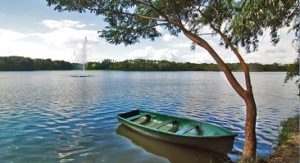 Karanji Lake is a lake located in the city of Mysore in the state of Karnataka, India. The lake is surrounded by a nature park consisting of a butterfly park and a walk-through aviary. This aviary is the biggest ‘walk-through aviary’ in India. There is also a museum, the Regional Museum of Natural History which is located on the banks of this lake. The total area of Karanji lake is 90 hectares. While waterspread area is about 55 hectares, the foreshore area measures about 35 hectares. Karanji lake is owned by the Mysore Zoo Authority. Mysore Zoo gets a revenue of an average of Rs. 50000 per day from ticket sales to enthusiasts who visit this lake.
Karanji Lake is a lake located in the city of Mysore in the state of Karnataka, India. The lake is surrounded by a nature park consisting of a butterfly park and a walk-through aviary. This aviary is the biggest ‘walk-through aviary’ in India. There is also a museum, the Regional Museum of Natural History which is located on the banks of this lake. The total area of Karanji lake is 90 hectares. While waterspread area is about 55 hectares, the foreshore area measures about 35 hectares. Karanji lake is owned by the Mysore Zoo Authority. Mysore Zoo gets a revenue of an average of Rs. 50000 per day from ticket sales to enthusiasts who visit this lake.
MYSORE ZOO
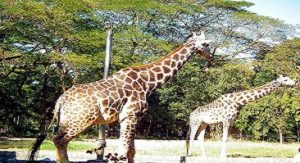 Mysore Zoo (Now Mysuru Zoo) (officially the Sri Chamarajendra Zoological Gardens) is a 157-acre (64 ha) zoo located near the palace in Mysore, India. It is one of the oldest and most popular zoos in India, and is home to a wide range of species (168). Mysore Zoo is one of the city’s most popular attractions.While mainly depending on entry fees for its financing, an adoption scheme introduced in the early 2000s has been a success. Celebrities, institutions,animal lovers and Volunteers of various clubs in the zoo have contributed directly to the welfare of the zoo inmates.
Mysore Zoo (Now Mysuru Zoo) (officially the Sri Chamarajendra Zoological Gardens) is a 157-acre (64 ha) zoo located near the palace in Mysore, India. It is one of the oldest and most popular zoos in India, and is home to a wide range of species (168). Mysore Zoo is one of the city’s most popular attractions.While mainly depending on entry fees for its financing, an adoption scheme introduced in the early 2000s has been a success. Celebrities, institutions,animal lovers and Volunteers of various clubs in the zoo have contributed directly to the welfare of the zoo inmates.
MYSORE PALACE
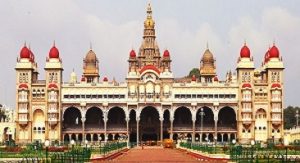 Ambavilas Palace otherwise known as the Mysore Palace is a historical palace and a royal residence at Mysore in the Indian State of Karnataka. It is the official residence of the Wadiyar dynasty and the seat of the Kingdom of Mysore. The palace is in the centre of Mysore, and faces the Chamundi Hills eastward. Mysore is commonly described as the ‘City of Palaces’, and there are seven palaces including this one; however, ‘Mysore Palace’ refers specifically to this one within the Old Fort.The land on which the palace now stands was originally known as puragiri (literally, citadel), and is now known as the Old Fort. Yaduraya built the first palace inside the Old Fort in the 14th century, which was demolished and constructed multiple times. The current structure was constructed between 1897 and 1912, after the Old Palace was burnt ablaze.Mysore Palace is now one of the most famous tourist attractions in India, after the Taj Mahal, with more than 6 million annual visitors.
Ambavilas Palace otherwise known as the Mysore Palace is a historical palace and a royal residence at Mysore in the Indian State of Karnataka. It is the official residence of the Wadiyar dynasty and the seat of the Kingdom of Mysore. The palace is in the centre of Mysore, and faces the Chamundi Hills eastward. Mysore is commonly described as the ‘City of Palaces’, and there are seven palaces including this one; however, ‘Mysore Palace’ refers specifically to this one within the Old Fort.The land on which the palace now stands was originally known as puragiri (literally, citadel), and is now known as the Old Fort. Yaduraya built the first palace inside the Old Fort in the 14th century, which was demolished and constructed multiple times. The current structure was constructed between 1897 and 1912, after the Old Palace was burnt ablaze.Mysore Palace is now one of the most famous tourist attractions in India, after the Taj Mahal, with more than 6 million annual visitors.
JAGAN MOHAN PALACE / JAYACHAMARAJENDRA ART GALLERY
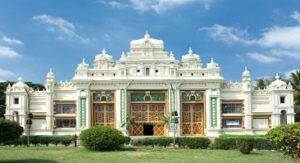 Jaganmohan Palace is a palace in Mysore, in the princely city of Mysore, India. Its construction was completed in 1861 and was initially used by the Wodeyars,Kings Of Mysore as their home (when the present majestic Mysore Palace (Amba Vilas Palace) was under construction after the old palace turned into ashes owing to a fire accident). It is now converted into an art gallery and a function hall. The palace is one of the seven palaces of the royal city of Mysore and one of the most beautiful contributions of the Wodeyar Kings of the city during their regime. The royal family has innumerable contributions not only to Mysore but also to some of the most important present metropolitans like Bangalore.
Jaganmohan Palace is a palace in Mysore, in the princely city of Mysore, India. Its construction was completed in 1861 and was initially used by the Wodeyars,Kings Of Mysore as their home (when the present majestic Mysore Palace (Amba Vilas Palace) was under construction after the old palace turned into ashes owing to a fire accident). It is now converted into an art gallery and a function hall. The palace is one of the seven palaces of the royal city of Mysore and one of the most beautiful contributions of the Wodeyar Kings of the city during their regime. The royal family has innumerable contributions not only to Mysore but also to some of the most important present metropolitans like Bangalore.
ST. PHILOMENA’S CATHEDRAL
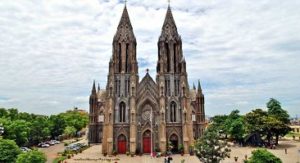 The church is dedicated to 3rd century saint Philomena who was the daughter of the monarch of a small state in Greece. Her parents were childless for several years. They prayed Jesus to bless them with a child and the next year Philomena was born to them. Even in her childhood Philomena showed signs of piety. When Philomena was 13 years old her father took her to Rome to obtain the favour of Emperor Diocletian. The Emperor was enthralled by her beauty and wanted to marry her. But she refused and vowed to give herself to God. She was tortured and beheaded in Rome. But people’s devotion for her spread near and far and she was given sainthood.
The church is dedicated to 3rd century saint Philomena who was the daughter of the monarch of a small state in Greece. Her parents were childless for several years. They prayed Jesus to bless them with a child and the next year Philomena was born to them. Even in her childhood Philomena showed signs of piety. When Philomena was 13 years old her father took her to Rome to obtain the favour of Emperor Diocletian. The Emperor was enthralled by her beauty and wanted to marry her. But she refused and vowed to give herself to God. She was tortured and beheaded in Rome. But people’s devotion for her spread near and far and she was given sainthood.
Drop at Mysore Hotel / Over Night Stay In Mysore End of a One Day Mysore Local Sightseeing Tour…
Itinerary for Day 2 Srirangapatna Sigtseeing Tour
About Srirangapatna
Srirangapatna is one of Karnataka’s most storied locations, a confluence of trade and culture from the heydays of the Vijaynagar Empire. Its most famous legacy though is the bastion of two great Deccan kings, Hyder Ali and his son, Tipu Sultan. Under Tipu Sultan, the Mysore kingdom reached the heights of its power and expanded aggressively across South India. A visit to present day Srirangapatna, which was the capital of this kingdom, will take visitors back in time to this glorious and bygone age.
DAY 2 PICKUP FROM MYSORE: Hotel / After Brakefast Chekout and proceed Srirangapatna Sightseeing places including:
SRIRANGAPATNA FORT
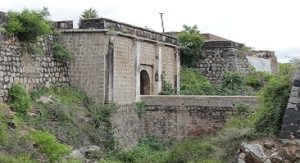 Srirangapatna Fort is a historical fort located in Sringapatna, the historical capital city in the South Indian state of Karnataka. Built by the Timmanna Nayaka in 1454, the fort came to prominence during the rule of Tipu Sultan. The fort was fully fortified and the architecture was modified with the help of French architects to meet the growing needs of saving against invaders. The river Kaveri surrounds the fort in one of the sides. The fort is protected in the West and Northern directions by river Cauvery. The fort had Lal Mahal and Tipu’s palace, which were demolished during the British capture of 1799. There are seven outlets and two dungeons.
Srirangapatna Fort is a historical fort located in Sringapatna, the historical capital city in the South Indian state of Karnataka. Built by the Timmanna Nayaka in 1454, the fort came to prominence during the rule of Tipu Sultan. The fort was fully fortified and the architecture was modified with the help of French architects to meet the growing needs of saving against invaders. The river Kaveri surrounds the fort in one of the sides. The fort is protected in the West and Northern directions by river Cauvery. The fort had Lal Mahal and Tipu’s palace, which were demolished during the British capture of 1799. There are seven outlets and two dungeons.
SRI RANGANATHASWAMY TEMPLE
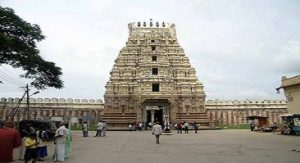 The Ranganthaswamy temple (usually referred to as “Sri Ranganathaswamy”) in Srirangapatna, in the Mandya district of Karnataka state, India, is dedicated to the Hindu god Ranganatha (a manifestation of the god Vishnu). It is one of the five important pilgrimage sites of Sri Vaishnavism along the river Kaveri for devotees of Ranganatha. These five sacred sites are together known as Pancharanga Kshetrams in Southern India. Since Srirangapatna is the first temple starting from upstream, the deity is known as Adi Ranga (lit; “first Ranga”).The town of Srirangapatna, which derives its name from the temple, is located on an island in the river Kaveri.
The Ranganthaswamy temple (usually referred to as “Sri Ranganathaswamy”) in Srirangapatna, in the Mandya district of Karnataka state, India, is dedicated to the Hindu god Ranganatha (a manifestation of the god Vishnu). It is one of the five important pilgrimage sites of Sri Vaishnavism along the river Kaveri for devotees of Ranganatha. These five sacred sites are together known as Pancharanga Kshetrams in Southern India. Since Srirangapatna is the first temple starting from upstream, the deity is known as Adi Ranga (lit; “first Ranga”).The town of Srirangapatna, which derives its name from the temple, is located on an island in the river Kaveri.
DARIA DAULAT BAGH / TIPU SULTAN SUMMER PALACE
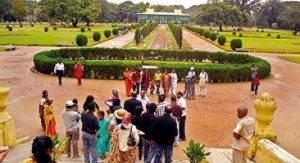 Srirangapatna is an island in the river Kaveri, about 14 km from Mysore. In Srirangapatna is the Dariya Daulat Palace (Summer Palace) that is set amidst beautiful gardens called Daria Daulat Bagh. Tippu Sultan popularly known as the “Tiger of Mysore”, built this palace in 1784 and ruled Mysore from here for a short time after his father Hyder Ali wrested power from the Wodeyars in the middle of the 18th century. The palace is built in the Indo-Sarcenic style in mostly made of teakwood. The palace has a rectangular plan and is built on a raised platform. There are open corridors along the four sides of the platform with wooden pillars at the edges of the Plinth. The western and eastern wings have walls the other two wings have recessed bays with pillars supporting the roof.
Srirangapatna is an island in the river Kaveri, about 14 km from Mysore. In Srirangapatna is the Dariya Daulat Palace (Summer Palace) that is set amidst beautiful gardens called Daria Daulat Bagh. Tippu Sultan popularly known as the “Tiger of Mysore”, built this palace in 1784 and ruled Mysore from here for a short time after his father Hyder Ali wrested power from the Wodeyars in the middle of the 18th century. The palace is built in the Indo-Sarcenic style in mostly made of teakwood. The palace has a rectangular plan and is built on a raised platform. There are open corridors along the four sides of the platform with wooden pillars at the edges of the Plinth. The western and eastern wings have walls the other two wings have recessed bays with pillars supporting the roof.
GAMBAZ
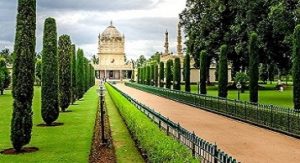 The Gumbaz is designed in the Persian style, with a large rectangle shaped garden, having a path leading to the mausoleum. In the middle of the garden, the Gumbaz stands on an elevated platform. The dome is supported by sharply cut black granite pillars. The doors and windows have lattice work cut through in stone on the same black granite material. The walls inside are painted with tiger stripes, the colours of Tippu Sultan. The three graves of Tippu Sultan, his father Hyder Ali and his mother Fakr-Un-Nisa are located inside the mausoleum. Many of Tippu’s relatives are buried outside the mausoleum in the garden. Most of the grave inscriptions are in Farsi. Next to the Gumbaz is the Masjid-E-Aksa, which was also built by Tippu Sultan
The Gumbaz is designed in the Persian style, with a large rectangle shaped garden, having a path leading to the mausoleum. In the middle of the garden, the Gumbaz stands on an elevated platform. The dome is supported by sharply cut black granite pillars. The doors and windows have lattice work cut through in stone on the same black granite material. The walls inside are painted with tiger stripes, the colours of Tippu Sultan. The three graves of Tippu Sultan, his father Hyder Ali and his mother Fakr-Un-Nisa are located inside the mausoleum. Many of Tippu’s relatives are buried outside the mausoleum in the garden. Most of the grave inscriptions are in Farsi. Next to the Gumbaz is the Masjid-E-Aksa, which was also built by Tippu Sultan
TRIVENI SANGAMA
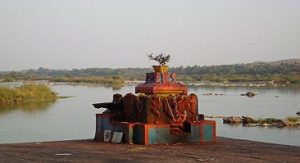 ‘Triveni Sangam is the “confluence” of three rivers We undertake all types of ritual services like asthi visarjane,aparakarma,narayanbhali,thilahoma,pretha samsara,pinda pradhana Sangam, located near a temple, is the confluence of three rivers. At this point, other branch of the River Cauvery, Loakpavani is reunited. … River Cauvery flows into the Mettur Dam in Tamil Nadu, from the point of confluence. It is the meeting point of Kabini River, Hemavati River and River Cauvery.
‘Triveni Sangam is the “confluence” of three rivers We undertake all types of ritual services like asthi visarjane,aparakarma,narayanbhali,thilahoma,pretha samsara,pinda pradhana Sangam, located near a temple, is the confluence of three rivers. At this point, other branch of the River Cauvery, Loakpavani is reunited. … River Cauvery flows into the Mettur Dam in Tamil Nadu, from the point of confluence. It is the meeting point of Kabini River, Hemavati River and River Cauvery.
RANGANATHITTU BIRD SANCTUARY
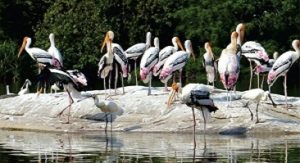 Ranganathittu Bird Sanctuary, also known as Pakshi Kashi of Karnataka, is a bird sanctuary in the Mandya District of the state of Karnataka in India.It is the largest bird sanctuary in the state,only 40 acres (16 ha) in area,and comprises six islets on the banks of the Kaveri river. Ranganathittu is located three kilometers away from the historic town of Sringapatna and 16 kilometres (9.9 mi) north of Mysore.The sanctuary attracted about 3 lakh visitors during 2016–17, which shows its notability as important bird sanctuary of India.During winter months, starting from mid-December, as many as 40,000 birds congregate in this bird sanctuary. Of which, some birds come from Siberia, Latin America and parts of north India. Ranganathittu is a popular nesting site for the birds and about 8,000 nestlings were sighted during June 2011.
Ranganathittu Bird Sanctuary, also known as Pakshi Kashi of Karnataka, is a bird sanctuary in the Mandya District of the state of Karnataka in India.It is the largest bird sanctuary in the state,only 40 acres (16 ha) in area,and comprises six islets on the banks of the Kaveri river. Ranganathittu is located three kilometers away from the historic town of Sringapatna and 16 kilometres (9.9 mi) north of Mysore.The sanctuary attracted about 3 lakh visitors during 2016–17, which shows its notability as important bird sanctuary of India.During winter months, starting from mid-December, as many as 40,000 birds congregate in this bird sanctuary. Of which, some birds come from Siberia, Latin America and parts of north India. Ranganathittu is a popular nesting site for the birds and about 8,000 nestlings were sighted during June 2011.
BRINDAVAN GARDENS
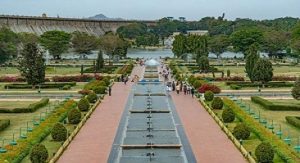 Brindavan Gardens is a famous & beautiful garden laid out below the Krishnaraja Sagar Dam. The construction work of the garden was started in the year 1927 and completed in 1932. This is one of the best tourist places to visit in Mysore.The garden was designed by Sir Mirza Ismail, Diwan of Mysore based on Shalimar Gardens of Kashmir in the Mughal style. Spread over an area of 150 acres, the Brindavan Gardens is considered as one of the best gardens in India. The garden is enriched with fountains, terraces, parterres, running and cascading water channels, lush green lawns & flower beds.The Musical and dancing fountain, located in the North Brindavan Garden, is the main attraction of the garden. The best time to visit the gardens is after sunset when all the bright colourful fountains come alive. The garden also has a wonderful palace in southern park which is now converted to a 4-star luxery hotel called Royal Orchid.
Brindavan Gardens is a famous & beautiful garden laid out below the Krishnaraja Sagar Dam. The construction work of the garden was started in the year 1927 and completed in 1932. This is one of the best tourist places to visit in Mysore.The garden was designed by Sir Mirza Ismail, Diwan of Mysore based on Shalimar Gardens of Kashmir in the Mughal style. Spread over an area of 150 acres, the Brindavan Gardens is considered as one of the best gardens in India. The garden is enriched with fountains, terraces, parterres, running and cascading water channels, lush green lawns & flower beds.The Musical and dancing fountain, located in the North Brindavan Garden, is the main attraction of the garden. The best time to visit the gardens is after sunset when all the bright colourful fountains come alive. The garden also has a wonderful palace in southern park which is now converted to a 4-star luxery hotel called Royal Orchid.
Drop at Mysore Hotel / Over Night Stay In Mysore End of a Day 2 Mysore Local Sightseeing Tour…
Itinerary for Day 3 Wayanad Sigtseeing Tour
About Wayanad
Wayanad, the green paradise is nestled among the mountains of the Western Ghats, forming the border world of the greener part of Kerala. Clean and pristine, enchanting and hypnotizing, this land is filled with history and culture. Located at a distance of 76 km. from wayanadthe sea shores of Kozhikode, this verdant hill station is full of plantations, forests and wildlife. Wayanad hills are contiguous to Mudumalai in Tamil Nadu and Bandhipur in Karnataka, thus forming a vast land mass for the wild life to move about in their most natural abode.
DAY 3 PICKUP FROM MYSORE: Hotel / After Brakefast and Chekout proceed Wayanad Sightseeing places including:
BANASURA SAGAR DAM
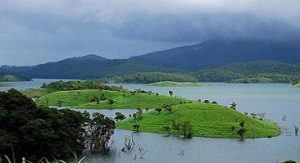 The dam was built in 1979 under the Indian Banasura Sagar Project that was started with an aim of supporting the Kakkayam Hydro Electric Power Project. This project also aimed at contributing to the drinking water and irrigation requirements of the locals during the hot summer season. Banasura Sagar Dam is made up of massive stacks of stones and boulders. The reservoir is marked with a cluster of small islands which were formed when the reservoir submerged the surrounding areas during monsoon season. These islands with the background of the Banasura hill provide a mesmerizing sight to the tourists.
The dam was built in 1979 under the Indian Banasura Sagar Project that was started with an aim of supporting the Kakkayam Hydro Electric Power Project. This project also aimed at contributing to the drinking water and irrigation requirements of the locals during the hot summer season. Banasura Sagar Dam is made up of massive stacks of stones and boulders. The reservoir is marked with a cluster of small islands which were formed when the reservoir submerged the surrounding areas during monsoon season. These islands with the background of the Banasura hill provide a mesmerizing sight to the tourists.
POOKOTE LAKE
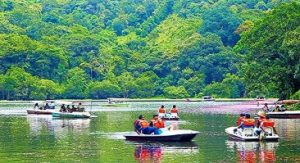 The lake has abundance of blue lotus and fresh water fishes. Pethia pookodensis is a species of cyprinid fish known to occur only in Pookode Lake. The forests surrounding the lake hold many wild animals, birds and flies. The view of this vast expanse of water in the picturesque backdrop is breathtakingly beautiful. There is a path built around the lake, perfect for a leisurely stroll. The route between Kozhikode highway and Pookote Lake is lined with tall and thick vegetation which offers beautiful driving experience.The lake is under the South Wayanad forest division and run by District Tourism promotion council. Boating facilities, children’s park, handicrafts and spices emporium and fresh water aquarium are among the tourist attractions here. The lake premises also offer fish spa which is quite famous here.
The lake has abundance of blue lotus and fresh water fishes. Pethia pookodensis is a species of cyprinid fish known to occur only in Pookode Lake. The forests surrounding the lake hold many wild animals, birds and flies. The view of this vast expanse of water in the picturesque backdrop is breathtakingly beautiful. There is a path built around the lake, perfect for a leisurely stroll. The route between Kozhikode highway and Pookote Lake is lined with tall and thick vegetation which offers beautiful driving experience.The lake is under the South Wayanad forest division and run by District Tourism promotion council. Boating facilities, children’s park, handicrafts and spices emporium and fresh water aquarium are among the tourist attractions here. The lake premises also offer fish spa which is quite famous here.
LAKKIDI VIEWPOINT
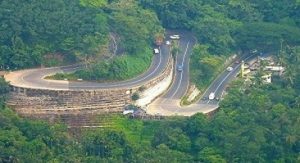 Often referred as ‘the gateway of Wayanad’, Lakkidi is located at the crest of the serpentine Thamarassery ghat pass, which features over 9 hairpin curves that start at Adivaram (downhill). The 12 km long ghat road from Adivaram to Lakkidi passing through thick forest leaves a wonderful experience. The lush green hills, gorges and streams on both sides of the passage up the hill are breathtaking sights to the visitors.This beautiful hill town has a number of scenic locations and enchanting viewpoints. Lakkidi Viewpoint is a popular viewpoint which offers dazzling views of the surrounding cliffs and valleys. Apart from Lakkidi Viewpoint, Pookote Lake is another popular attraction in Lakkidi. This is a natural fresh water lake, spread across 13 acres.
Often referred as ‘the gateway of Wayanad’, Lakkidi is located at the crest of the serpentine Thamarassery ghat pass, which features over 9 hairpin curves that start at Adivaram (downhill). The 12 km long ghat road from Adivaram to Lakkidi passing through thick forest leaves a wonderful experience. The lush green hills, gorges and streams on both sides of the passage up the hill are breathtaking sights to the visitors.This beautiful hill town has a number of scenic locations and enchanting viewpoints. Lakkidi Viewpoint is a popular viewpoint which offers dazzling views of the surrounding cliffs and valleys. Apart from Lakkidi Viewpoint, Pookote Lake is another popular attraction in Lakkidi. This is a natural fresh water lake, spread across 13 acres.
Drop at Wayanad Hotel / Over Night Stay In Wayanad End of a Day 3 Wayanad Local Sightseeing Tour…
Itinerary for Day 4 Wayanad Sigtseeing Tour
DAY 4 PICKUP FROM WAYANAD: Hotel / After Brakefast Chekout and proceed Wayanad Sightseeing places including:
EDAKKAL CAVES
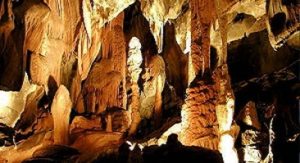 Situated an altitude of 4000 feet, these caves were discovered by Fred Fawcett, the then Superintendent of Police of the Malabar district in 1890, during his hunting trip to Wayanad. The name ‘Edakkal’ literally means ‘a stone in between’. Here one can see a cave formed by a heavy boulder straddling a fissure in the rock. Many legends are there behind the formation of Edakkal caves. According to one, these caves are said to be formed with the arrows fired by Lava and Kusha, the sons of Lord Sri Rama. Another one is associated with Kutti Chathan and the Goddess Mudiampilly. The local people used to have a pilgrimage trip to this place to honour the Goddess.
Situated an altitude of 4000 feet, these caves were discovered by Fred Fawcett, the then Superintendent of Police of the Malabar district in 1890, during his hunting trip to Wayanad. The name ‘Edakkal’ literally means ‘a stone in between’. Here one can see a cave formed by a heavy boulder straddling a fissure in the rock. Many legends are there behind the formation of Edakkal caves. According to one, these caves are said to be formed with the arrows fired by Lava and Kusha, the sons of Lord Sri Rama. Another one is associated with Kutti Chathan and the Goddess Mudiampilly. The local people used to have a pilgrimage trip to this place to honour the Goddess.
WAYANAD HERITAGE MUSEUM
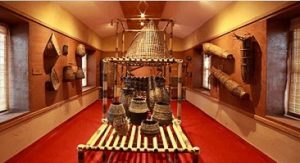 This is one of the best heritage museums in Kerala. The museum houses fascinating items from tribal communities dating back to the second century AD. It has a rare collection of several ancient instruments & tribal artifacts like jewellery, hunting and fishing weapons, farming instruments, a fine collection of 14th – 16th century sculptures, etc. Ancient terra cottas, stone weapons and local art are also on display at the museum.A series of pictorial rock edicts referred to as Hero Stones, memorialize a bygone age of warriors. There is a fine figure of the Goddess of fertility, Urvara, also displayed here. Most of the artifacts are collected from the Wayanad and surrounding regions.
This is one of the best heritage museums in Kerala. The museum houses fascinating items from tribal communities dating back to the second century AD. It has a rare collection of several ancient instruments & tribal artifacts like jewellery, hunting and fishing weapons, farming instruments, a fine collection of 14th – 16th century sculptures, etc. Ancient terra cottas, stone weapons and local art are also on display at the museum.A series of pictorial rock edicts referred to as Hero Stones, memorialize a bygone age of warriors. There is a fine figure of the Goddess of fertility, Urvara, also displayed here. Most of the artifacts are collected from the Wayanad and surrounding regions.
JAIN TEMPLE – SULTHAN BATHERY
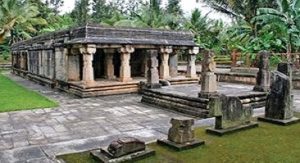 The Jain Temple at Sultan Bathery is believed to have been built in 13th century AD. The temple has an interesting history. It first served as a shrine, and then became an important center of commercial activity. Later in 18th century, it became a dumping ground of ammunitions by Tipu Sultan.The town of Sulthan Bathery was earlier known as Ganapathi Vattam and had 12 traditional Jain streets in and around the town. After Tipu’s vandalism, the temple was deserted for about 150 years. Later the Archaeological Survey of India took over the maintenance and declared it a monument of national importance. The courtyard is well laid with lawns and ornamental plants now.
The Jain Temple at Sultan Bathery is believed to have been built in 13th century AD. The temple has an interesting history. It first served as a shrine, and then became an important center of commercial activity. Later in 18th century, it became a dumping ground of ammunitions by Tipu Sultan.The town of Sulthan Bathery was earlier known as Ganapathi Vattam and had 12 traditional Jain streets in and around the town. After Tipu’s vandalism, the temple was deserted for about 150 years. Later the Archaeological Survey of India took over the maintenance and declared it a monument of national importance. The courtyard is well laid with lawns and ornamental plants now.
MUTHANGA WAYANAD WILDLIFE SANCTUARY
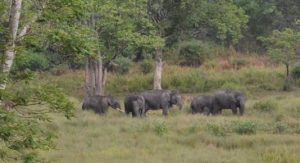 Established in 1973, Wayanad Wildlife Sanctuary was brought under the Project Elephant in the year 1991-92. The sanctuary is bordered with Nagarhole National Park & Bandipur WLS in Karnataka and Mudumalai WLS in Tamilnadu. Occupying an area of 345 sq. km, Wayanad WLS is the second largest WLS in Kerala and is now an integral part of the Nilgiri Biosphere Reserve. The sanctuary was set up with an objective of conserving the biological heritage of the region with due consideration to the general life style of tribes and others whose lives are dependent on the forest. The Western Ghats, Nilgiri Sub-Cluster, including all of the sanctuary, is under consideration by the UNESCO World Heritage Committee for selection as a World Heritage Site.
Established in 1973, Wayanad Wildlife Sanctuary was brought under the Project Elephant in the year 1991-92. The sanctuary is bordered with Nagarhole National Park & Bandipur WLS in Karnataka and Mudumalai WLS in Tamilnadu. Occupying an area of 345 sq. km, Wayanad WLS is the second largest WLS in Kerala and is now an integral part of the Nilgiri Biosphere Reserve. The sanctuary was set up with an objective of conserving the biological heritage of the region with due consideration to the general life style of tribes and others whose lives are dependent on the forest. The Western Ghats, Nilgiri Sub-Cluster, including all of the sanctuary, is under consideration by the UNESCO World Heritage Committee for selection as a World Heritage Site.
Drop at Mysore Hotel / Airport / Railway Station / Bus Station. End of a 4 days Mysore to Wayanad Local Sightseeing Tour
[Four Days Tour Car Rental Tariffs]
| Sl.No. | Cab Type | Per Day Non Ac | Per Day A/c | Add Km | Add Hrs | Parking Extra |
| 1 | Indica | Rs 1,400/- | Rs 1,600/- | Rs 08/- | Rs 150/- | Yes |
| 2 | Toyota Etios | Rs 1,800/- | Rs 2,100/- | Rs 10/- | Rs 200/- | Yes |
| 3 | Tavera | Rs 2,100/- | Rs 2,400/- | Rs 12/- | Rs 250/- | Yes |
| 4 | Innova | Rs 2,600/- | Rs 2,900/- | Rs 14/- | Rs 300/- | Yes |
| 5 | Tempo Traveller 12 + 1 Seater | Rs 4,200/- | Rs 4,600/- | Rs 16/- | Rs 400/- | Yes |
| 6 | Mini Bus 20 + 1 seater | Rs 5,200/- | Rs 5,600/- | Rs 26/- | Rs 400/- | Yes |
Guests are requested to follow the itinerary provided in the 4 Days Mysore To Wayanad Local Sightseeing tour package. This 4 days Karnataka tour package can not be customized, however if guests prefer to visit different set of places in Karnataka and around, they can create their own itinerary and request for a custom quote from cab providers.
